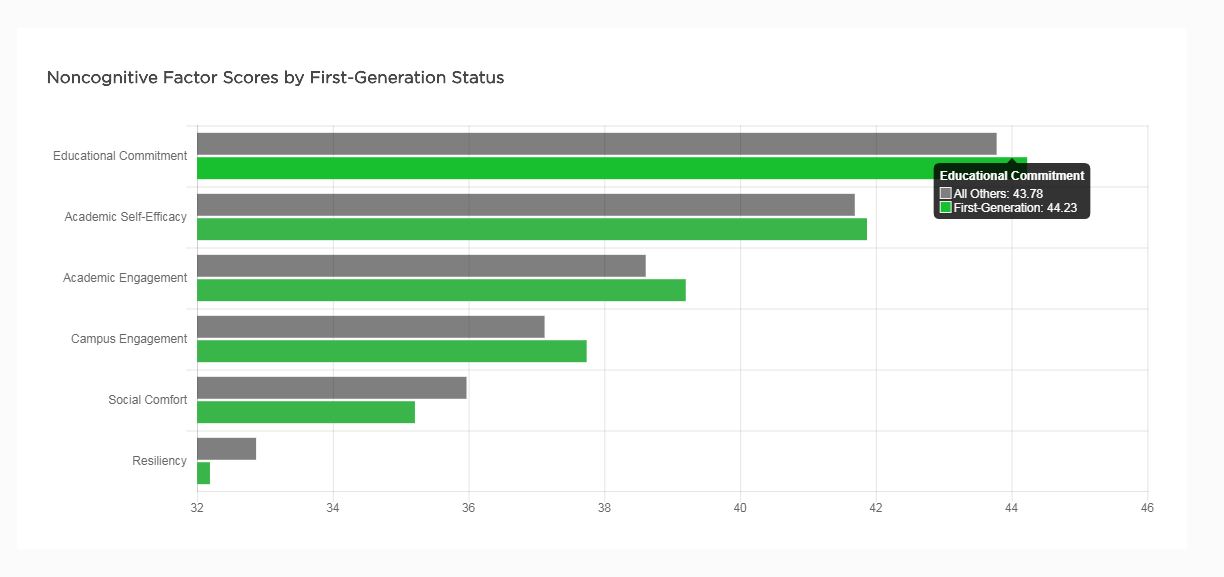You have /5 articles left.
Sign up for a free account or log in.
Popular perceptions of first-generation college students as being unsure about college and academically unprepared to succeed may not be true.
New research from Campus Labs, a higher education data collection and software company, examined the noncognitive skills of first-generation students and compared them to their multigenerational peers, finding that first-generation students are more engaged and committed to their education.
“Based on the literature, one would have negative assumptions and expect first-generation students to be lower in academic engagement, because the literature says first-generation students are academically unprepared,” said Shannon LaCount, an assistant vice president of campus adoption at Campus Labs. “But they’re right there with multigenerational students or they’re scoring higher. It says to me that first-generation students are coming in with an attitude that they are academically prepared and they can handle the work.”
Campus Labs measured responses to roughly 40 questions from students at more than 60 colleges and universities that work with the company. The colleges' demographics, locations and sizes varied, but most are four-year American institutions.
About 750,000 students responded during the initial weeks of their first academic terms on campus. The company reported that 14 percent of respondents said neither of their parents nor a guardian held a four-year degree. Campus Labs then scored responses from this group of first-generation students on six noncognitive factors -- educational commitment, academic self-efficacy, academic engagement, campus engagement, social comfort and resiliency.
The first-generation students outscored their peers in educational commitment, self-efficacy, academic and campus engagement. But they lagged behind multigenerational students in resiliency -- or the ability for students to overcome challenging situations and stressful events -- and social comfort.
“It’s true that first-generation students may not know the structure of the language or follow the higher education culture because [they] haven’t been exposed,” LaCount said. “[They] may be naïve walking in, but it doesn’t mean [they’re] not capable.”
Tiffany Jones, the director of higher education policy at Education Trust and herself a former first-generation student, said she is not surprised that first-generation students have a lower sense of comfort on college campuses.
“First-generation students feel it is such a privilege to go to college,” she said. “It’s why they’re more engaged. They want to chart and clear a path for those coming behind them.”
A Growing Population
Campus Labs studied responses from students on five additional statements. For this survey, the company chose a sample of 53,000 students, of which 32,000 self-reported first- or multigenerational status, with 29 percent identifying as first generation. This sample of students may or may not include the same students who responded about the noncognitive factors, LaCount said.
Fully 91 percent of first-generation students disagreed with the statement "I sometimes wonder if attending college was the right decision," while only 84 percent of non-first-generation students disagreed. Both groups of students gave similar responses to the four other statements.
LaCount said the responses from first-generation students show that colleges need to be more careful about the language they use about the group, especially if it’s creating negative assumptions that don’t help these students complete.
“The negative language leads to a narrative that students are unsupported, and that’s not necessarily true,” she said. “It also assumes [first-generation] students are coming from poverty or have a lack of education, and that’s not always the case, either. There are a lot of successful people out there who didn’t get college degrees, and yet their [children] would be first generation and it’s not a deficit.”
There’s also a perception that first-generation students are navigating college alone. LaCount said they could be supported by their families, it’s just that they and their families often don’t have experience with the financial aid or college registration processes.
“First-generation students feel significant pressure,” said Wil Del Pilar, vice president of higher education policy and practice for Education Trust, who was also a first-generation student. “When I graduated I had 18 people there, because I was the first to do it. Everyone wanted to celebrate, but with that came an incredible amount of pressure. I went to college with my mom, my dad, four other siblings … and a bazillion cousins. It opened doors for other folks in my family.”
John Gardner, chief executive officer of the Gardner Institute for Excellence in Undergraduate Education, a nonprofit organization that partners with colleges to help them improve outcomes, said much of the research on first-generation students tends to come from graduate research centers, where those students are not well represented.
“They’re columns that have to be solved and plugged into a system that wasn’t designed for them,” he said, adding that the demographics in colleges are changing, with more students identifying as first generation. Many first-generation students come from low-income backgrounds and aren’t white men, Gardner said.
According to the American Association of Community Colleges, the percentage of first-time community college students who identify as Hispanic increased from 13 percent in 2001 to 26 percent in 2016. The population of black first-time students during that same time period has remained flat, while the percentage of white first-time students declined from 61 percent to about 44 percent.
First-generation students enter college with confidence in themselves and eagerness to participate in student activities on campus, LaCount said, but their low responses in the resiliency factor show where colleges can step in and be more helpful.
On the resiliency questions, students were asked to respond to whether they believe they can navigate stressful situations in college. LaCount said first-generation students scored low in that area because they’re being asked to navigate an environment that often feels unfamiliar.
“The first thing is to recognize if a student is struggling in the class, it might not be because they are not valuing higher education or they’re not committed to being in the class,” she said. “We don’t immediately have to jump to the idea that a student can’t handle the content. It may be they don’t know the resources available to help, or they may have a different way of thinking and need more time. To immediately assume first-generation students will struggle academically is a bit unfair.”
Gardner said colleges have an opportunity to create an environment where first-generation students, especially those who are racial and ethnic minorities, see more leaders who come from similar backgrounds. And faculty members shouldn’t lower their expectations of these students, he said. Arizona Western College, for instance, launched a campaign last year called "I Am First Gen," for students to celebrate being the first in their families to attend college and to connect with faculty and staff members who also self-identified as being first-generation students.
“You take students into a college setting and you have to teach them how to meet those expectations,” Gardner said. “You don’t just give them a syllabus and say, ‘Here, do it,’ as if it’s magic.”
Showing first-generation students the resources that are available to them will require more flexibility from colleges.
“Think of two-day orientations,” Del Pilar said. “If I’m low income or a first-generation [student’s] parent, I may not be able to take time off from work to go … those are created for upper-middle-class parents who can take time off work to support students.”
Del Pilar also said he doesn’t buy the notion that multigenerational students are more resilient.
“They have the networks and the people they can draw on to get this information,” he said. “The social capital piece can’t be underplayed … they have more access to information and resources.”






